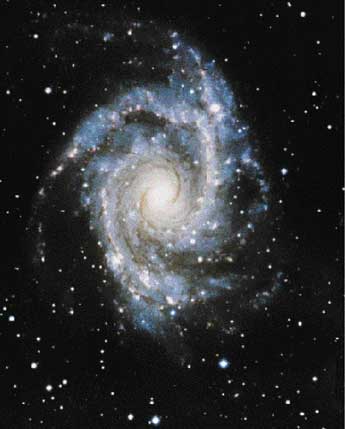 | Hot blue-white stars light up the graceful spiral arms of Galaxy NGC 2997. |
lasting fame as a scientist, but he also is justly renowned for deriving a powerful equation known as the law of universal gravitation  . .
The genesis of that insight makes for perhaps the most famous tall tale in the history of science. As Newton sat under an apple tree and watched the Moon, the story goes, an apple fell from its branch and struck him on the head. At that point, Newton realized that the force drawing the apple to the ground and the force keeping the Moon in its orbit around Earth  were one and the same. (Most historians believe that Newton did indeed see an apple fall to the ground, but it almost certainly did not hit his head.) No matter how it actually happened, Newton was the first scientist to recognize that the laws of nature link everything above, beneath, and around us into one universe. were one and the same. (Most historians believe that Newton did indeed see an apple fall to the ground, but it almost certainly did not hit his head.) No matter how it actually happened, Newton was the first scientist to recognize that the laws of nature link everything above, beneath, and around us into one universe.
Newton explained that gravity pulls toward a center, not just down to the surface. In other words, the apple fell toward Earth's center, and Newton's head happened to get in the way. His equation shows that gravity's strength decreases with the square of the distance between two objects. If the distance between the center of the Sun and a comet is tripled, the gravitational force between them is one-ninth as strong. Further, the force depends directly on the mass of the object doing the pulling. Mars would attract the apple with less force than Earth because of that planet's lower mass, whereas Jupiter's pull would be much greater. If you've ever stepped on one of those  scales at a planetarium that reveals how much you would weigh on another planet, you've participated in a calculation of the law of universal gravitation scales at a planetarium that reveals how much you would weigh on another planet, you've participated in a calculation of the law of universal gravitation  . .
That equation and Newton's second law of motion predict that gravity will accelerate two things of different masses at exactly the same rate. Galileo  demonstrated this nearly a century before Newton by rolling and sliding demonstrated this nearly a century before Newton by rolling and sliding  smooth objects down inclined tracks. In a tale that likely has a kernel of truth, he also dropped cannonballs of unequal masses from the Leaning smooth objects down inclined tracks. In a tale that likely has a kernel of truth, he also dropped cannonballs of unequal masses from the Leaning  Tower of Pisa to prove that they hit the ground at the same time. Apollo 15 Tower of Pisa to prove that they hit the ground at the same time. Apollo 15  astronaut David Scott dropped a hammer and a falcon feather onto the Moon's surface in 1971 to show the same thing. (Scott's trick won't work in your living room because air resistance on Earth makes a feather flutter rather than fall.) Indeed, the practical significance of gravity's equal acceleration of objects is critical in the space program. For instance, NASA engineers don't need to (continued) astronaut David Scott dropped a hammer and a falcon feather onto the Moon's surface in 1971 to show the same thing. (Scott's trick won't work in your living room because air resistance on Earth makes a feather flutter rather than fall.) Indeed, the practical significance of gravity's equal acceleration of objects is critical in the space program. For instance, NASA engineers don't need to (continued) |

